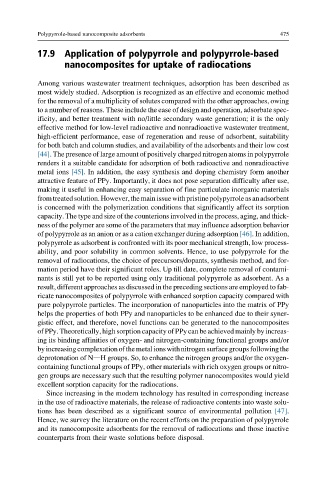Page 522 - Polymer-based Nanocomposites for Energy and Environmental Applications
P. 522
Polypyrrole-based nanocomposite adsorbents 475
17.9 Application of polypyrrole and polypyrrole-based
nanocomposites for uptake of radiocations
Among various wastewater treatment techniques, adsorption has been described as
most widely studied. Adsorption is recognized as an effective and economic method
for the removal of a multiplicity of solutes compared with the other approaches, owing
to a number of reasons. These include the ease of design and operation, adsorbate spec-
ificity, and better treatment with no/little secondary waste generation; it is the only
effective method for low-level radioactive and nonradioactive wastewater treatment,
high-efficient performance, ease of regeneration and reuse of adsorbent, suitability
for both batch and column studies, and availability of the adsorbents and their low cost
[44]. The presence of large amount of positively charged nitrogen atoms in polypyrrole
renders it a suitable candidate for adsorption of both radioactive and nonradioactive
metal ions [45]. In addition, the easy synthesis and doping chemistry form another
attractive feature of PPy. Importantly, it does not pose separation difficulty after use,
making it useful in enhancing easy separation of fine particulate inorganic materials
fromtreatedsolution.However,themainissuewithpristinepolypyrroleasanadsorbent
is concerned with the polymerization conditions that significantly affect its sorption
capacity. The type and size of the counterions involved in the process, aging, and thick-
ness of the polymer are some of the parameters that may influence adsorption behavior
of polypyrrole as an anion or as a cation exchanger during adsorption [46]. In addition,
polypyrrole as adsorbent is confronted with its poor mechanical strength, low process-
ability, and poor solubility in common solvents. Hence, to use polypyrrole for the
removal of radiocations, the choice of precursors/dopants, synthesis method, and for-
mation period have their significant roles. Up till date, complete removal of contami-
nants is still yet to be reported using only traditional polypyrrole as adsorbent. As a
result, different approaches as discussed in the preceding sections are employed to fab-
ricate nanocomposites of polypyrrole with enhanced sorption capacity compared with
pure polypyrrole particles. The incorporation of nanoparticles into the matrix of PPy
helps the properties of both PPy and nanoparticles to be enhanced due to their syner-
gistic effect, and therefore, novel functions can be generated to the nanocomposites
of PPy. Theoretically, high sorption capacity of PPy can be achieved mainly by increas-
ing its binding affinities of oxygen- and nitrogen-containing functional groups and/or
byincreasingcomplexationofthemetalionswithnitrogensurfacegroupsfollowingthe
deprotonation of NdH groups. So, to enhance the nitrogen groups and/or the oxygen-
containing functional groups of PPy, other materials with rich oxygen groups or nitro-
gen groups are necessary such that the resulting polymer nanocomposites would yield
excellent sorption capacity for the radiocations.
Since increasing in the modern technology has resulted in corresponding increase
in the use of radioactive materials, the release of radioactive contents into waste solu-
tions has been described as a significant source of environmental pollution [47].
Hence, we survey the literature on the recent efforts on the preparation of polypyrrole
and its nanocomposite adsorbents for the removal of radiocations and those inactive
counterparts from their waste solutions before disposal.

